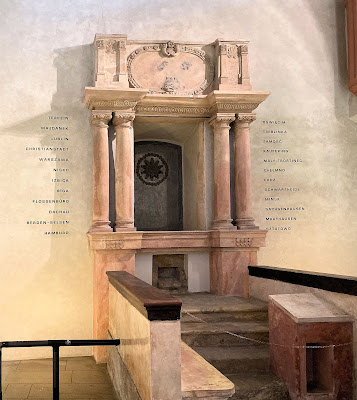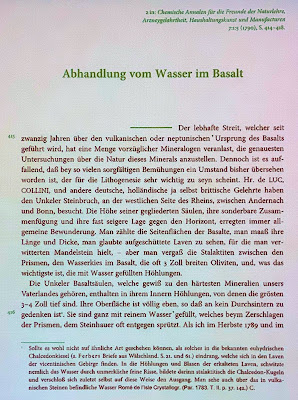
|
|
Tycho Brahe and Johannes Kepler at Pohorelec and in bronze
|
Tycho Brahe and
Johannes Kepler were
astronomers and astrologers at the imperial court of
Rudolf II, who, in 1583, had moved his seat of government from Vienna to Prague. With
this move, he had further irritated the Habsburg clan, who already regarded
"their" melancholic emperor as
blödhäuptig (silly-headed). As
Golo Mann writes,
"Rudolf possessed high intelligence when the urge of the moment did not cloud
it." He was particularly interested in the science of his time, like alchemy
and astrology.
As the best solution to the Rudolf problem, the Habsburgs considerably reduced
his financial support. So the emperor was forced, although a fervent Catholic
himself, to make a pact with the Protestant Bohemian estates. Their
quid pro quo was financial support to the court against religious
liberties.

|
|
Rudolf's Letter of Majesty in the Czech language
|
So on July 9, 1609, Rudolf guaranteed in his Letter of Majesty to the followers
of the Bohemian Confession, the Czech Hussites and brothers in faith, "From this
day forth no one ... shall be pushed aside by [his] religion and forced to
another faith by force or in any conceived way."
The document guaranteed the Ultraquists* not only freedom of religion but also
the privilege of building churches and establishing schools. Prague University
became Protestant.
*receiving the Holy Communion under both Species

|
| ©P. Habison |
This situation culminated in a fight between two prominent brothers, Empereur
Rudolf II and the younger Archduke
Matthias. In the end, Rudolf was forced to abdicate.
Brahe and Kepler met for the first time on February 6, 1600, well before the
fraternal quarrel, at Benatek Castle, Brahe's residence, located 50 km
outside Prague.
Why do I write all this? Red Baron spent five days with a group on a
guided tour of Prague and its surroundings. When I first read the announcement
of "
Tycho Brahe und Johannes Kepler in Prag," I was all excited.
Studiosus, one of the better German
tour organizers, offered this one-time specialized trip.
In the following, I will no longer dig into the historical situation on the eve
of the Thirty Years War but rather concentrate on the tour. My German-speaking
friends may
read the full story and history here.
As usual, Studiosus had all well organized. At times, three guides looked at the overall organization, explained the implications of Brahe's and Kepler's
discoveries for the development of astronomy, and showed us the beauties of
Prague. The organizer was a man from Budapest speaking fluent German*, the
astronomer-physicist was from Vienna, and the local guide was a Bohemian lady from
Prague.
*His German was too good, clearly indicating that he was foreign (cf. My Fair Lady, the story about the Hungarian professor)

|
|
St. Norbert, in his recess, just does not get it.
|
In general, English was the language to converse in shops and restaurants, but
our three guides communicated in the classical
lingua franca of the gone
by Danube Monarchy, speaking German. I was moved.

|
|
The beautiful Elbe Valley
|
Coming from the
Berlin wedding, I had a night-over at Dresden and took the train along the Elbe River to
Prague the following morning.

|
|
Distinguish the famous Bastei bridge. |
It was a pleasant ride along the Elbe Valley, passing the famous Elbe Sandstone
Mountains.
The train named Berliner originated from Kiel on the Baltic Sea, touched Berlin
and Dresden, and had accumulated a delay of only 10 minutes when we reached
Prague.

|
|
First impression: Prague's Wenceslas Square by night
|
The following morning started with a series of lectures by Dr. Peter Habison on
Brahe and Kepler.

|
| ©P. Habison |
Tycho Brahe became famous as an astronomer when he discovered and described the
supernova of 1572. Its luminosity was so high that he could observe the
bursting star with the naked eye.

|
| ©P. Habison |
He also observed and described the comet of 1577.

|
| A sextant |

|
|
A replica of a Brahe quadrant at Benatec Castle
|
Brahe observed all his astronomical data, including those on the
movement of planets with the naked eye, using well-adjusted sextants and
quadrants.

|
|
Commemorative plaque for Smetana above the entry to Benatec Castle
|
Most people visit Benatec Castle not because of Brahe but because of Bedrich Smetana. The
composer of "The Moldavia" lived here from 1844 to 1847.
Back to our protagonists. Enter Kepler. He needed Brahe's precisely measured
data badly for the exact calculation of the Mars planetary orbit. Initially,
Brahe refused to give those away. You will find the full dramatic interhuman
story between those two giants of science on Wikipedia.
Eventually, Kepler got the data following Brahe's death in 1601. He dedicated
the publication to Emperor Rudolf.
In 1609, Kepler finally had his
Astronomia Nova published, in which
he, based on Brahe's precise observation data, calculated the slightly
elliptical orbit of the planet Mars precisely. In his book, Kepler also
formulated two of his laws as there are:
1. Planets move in elliptical orbits with the Sun at one focus.
2. The speed of the planet changes at each moment so that the time between two
positions is always proportional to the area swept over on the orbit between
these positions.

|
Only a few contemporary "scientists" understood and
appreciated Kepler's Astronomia Nova (©P. Habison)
|
Only 75 years later,
Isaac Newton fully understood Kepler's writings by applying to the orbiting planets in
Kepler's Laws one of the basic principles in physics, the Conservation Laws, in
this case, the conservation of angular momentum. In 1684, Newton published the paper
De motu corporum in Hyrum.
In the following, I would like to show you some of my photos taken during our
guided tours.
A visit to the castle

|
|
Approaching St. Vitus cathedral at the castle ground
|

|
|
A look into the choir that was still finished in the Middle Ages
|

|
St. John of Nepomuk's drama in three acts is shown in one painting in the St
Vitus Cathedral:
1. Nepomuk hears the Queen's confession.
2. King
Wenceslaus
demands Nepomuk to divulge the secrets of the Queen's confession.
3. Nepomuk refuses, is thrown from Charles Bridge, and drowns in the
Moldavia river.
|

|
Crowds of tourists passing the great hall at the castle
on their way to and from the site of the 1618 defenestration.
|

|
|
Recovering with an Apfelstrudel (the best!) at the Castle Café
|

|
|
Changing of the guards at the castle
|

|
View from the castle unto the roofs of Prague.
Note the site of the German embassy in the back of the Palais Lobkowicz. |

|
|
Last view of the castle from Wallenstein's Gardens.
|
Downtown

|
|
An original vestige of Prague's University founded in 1348
|

|
|
Today's entry to the Universitas Carolina
|

|
|
A traffic light at Charles Bridge channels the crowds of tourists. |
Muzeum Speculum Alchemiae

|
| Making gold |

|
|
A problem everywhere: No drinks, no noise?
|
Library of the Strahov Monastery

|
|
"Science is difficult but fertile."
|

|
|
The interior is awe-inspiring...
|

|
|
... and the view down onto the Golden City, too.
|

|
|
Passing the Loreto Church ...
|

|
|
...discovering German street names ...
|

|
... and arriving at Tycho Brahe's house in the Castle Quarter, "The
Golden Griffin."
Dr. Peter Habison gave an outdoor lecture.
|
The Klementinum

|
|
The National Library of the Czech Republic
|

|
Breathtaking views from the astronomical tower (see above) on
Baroque St. Nicolas Church, Tyn's Church, and the Powder Tower
|

|
|
The Hradčany hill with the castle and St. Vitus Church are to the west.
|
Pinkas Synagogue, Old-New Synagogue. and Old Cemetary

|
On the walls of the Pinkas Synagogue are written the names of all the
Czech Jews
who perished in the Holocaust.
|

|
The Thora shrine at the Pinkas Synagogue is flanked
with the names of concentration camps
|

|
|
The Old Jewish Cemetary ...
|

|
|
... of the 15th century.
|

|
|
The oldest tombstone of Avigdor Kara from 1439
|

|
|
Rabbi Loew's tombstone of 1609
|

|
|
Interior of the Old New Synagogue where Rabbi Loew taught.
|

|
|
Rabbi Loew's seat in front of the Thora shrine, untouched.
|
The Golden City is a place to visit.
*


























































